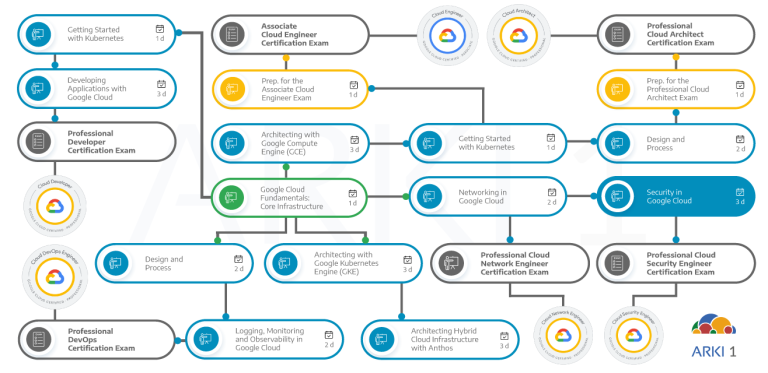Este curso de capacitación ofrece un amplio estudio de los controles y técnicas de seguridad en Google Cloud. A través de presentaciones, demostraciones y laboratorios, explorarás e implementarás los componentes de una solución segura en Google Cloud. Utilizarás servicios que incluyen Cloud Identity, Identity and Access Management (IAM), Cloud Load Balancing, Cloud IDS, Web Security Scanner, BeyondCorp Enterprise y Cloud DNS.
Objetivos
En este curso, los participantes aprenderán las siguientes habilidades:
- Identificar los fundamentos de la seguridad en Google Cloud.
- Administrar identidades de administración con Google Cloud.
- Implementar administración de usuarios con Identity and Access Management (IAM).
- Configurar Redes Privadas Virtuales (VPCs) para aislamiento, seguridad y registro.
- Aplicar técnicas y mejores prácticas para gestionar de forma segura Compute Engine.
- Aplicar técnicas y mejores prácticas para gestionar de forma segura los datos en Google Cloud.
- Aplicar técnicas y mejores prácticas para asegurar aplicaciones en Google Cloud.
- Aplicar técnicas y mejores prácticas para asegurar los recursos de Google Kubernetes Engine (GKE).
- Gestionar la protección contra ataques de denegación de servicio distribuido (DDoS).
- Gestionar vulnerabilidades relacionadas con el contenido.
- Implementar soluciones de monitoreo, registro, auditoría y escaneo en Google Cloud.
Público-Alvo
Esta clase está dirigida al siguiente público:
- Analistas, arquitectos e ingenieros de seguridad de la información en la nube.
- Especialistas en seguridad de la información o ciberseguridad.
- Arquitectos de infraestructura en la nube.
Prerrequisitos
Para aprovechar al máximo este curso, los participantes deben cumplir con los siguientes criterios:
- Conclusión previa del curso Google Cloud Fundamentals: Core Infrastructure o tener experiencia equivalente.
- Conclusión previa del curso Networking en Google Cloud o tener experiencia equivalente.
- Conocimiento de conceptos fundamentales en seguridad de la información, a través de experiencia o entrenamiento en línea como SANS SEC301: Introducción a la Seguridad Cibernética.
- Competencia básica con herramientas de línea de comandos y entornos del sistema operativo Linux.
- Experiencia en operaciones de sistemas, incluida la implementación y gestión de aplicaciones, ya sea localmente o en un entorno de nube pública.
- Comprensión de lectura de código en Python o Javascript.
- Comprensión básica de la terminología de Kubernetes (preferiblemente pero no requerido).
Duración
24 horas (3 días)
Inversión
Vea el valor actualizado y las próximas fechas de las clases abiertas en nuestra página de registro.
Si está interesado en una clase cerrada para su empresa, contáctenos.
Resumen del curso
El curso incluye presentaciones, demostraciones y laboratorios prácticos.
- Explain the shared security responsibility model of Google Cloud.
- Describe how Google Cloud approaches security.
- Recognize threats mitigated by Google and Google Cloud.
- Identify Google Cloud’s commitments to regulatory compliance.
- Describe what Cloud Identity is and what it does.
- Explain how Google Cloud Directory Sync securely syncs users and permissions between your on-premises LDAP or AD server and the cloud.
- Explore and apply best practices for managing groups, permissions, domains, and administrators with Cloud Identity.
- Identify IAM roles and permissions that can be used to organize resources in Google Cloud.
- Explain the management-related features of Google Cloud projects.
- Define IAM policies, including organization policies.
- Implement access control with IAM.
- Provide access to Google Cloud resources by using predefined and custom IAM roles.
- Describe the function of VPC networks.
- Recognize and implement best practices for configuring VPC firewalls (both ingress and egress rules).
- Secure projects with VPC Service Controls.
- Apply SSL policies to load balancers.
- Enable VPC flow logging, and then use Cloud Logging to access logs.
- Deploy Cloud IDS, and view threat details in the Google Cloud console.
- Create and manage service accounts for Compute Engine instances (default and customer-defined).
- Detail IAM roles and scopes for VMs.
- Explore and apply best practices for Compute Engine instances.
- Explain the function of the Organization Policy Service.
- Use IAM permissions and roles to secure cloud resources.
- Create and wrap encryption keys using the Compute Engine RSA public key certificate.
- Encrypt and attach persistent disks to Compute Engine instances.
- Manage keys and encrypted data by using Cloud Key Management Service (Cloud KMS) and Cloud HSM.
- Create BigQuery authorized views.
- Recognize and implement best practices for configuring storage options.
- Recall various types of application security vulnerabilities.
- Detect vulnerabilities in App Engine applications by using Web Security Scanner.
- Secure Compute Engine Applications by using BeyondCorp Enterprise.
- Secure application credentials by using Secret Manager.
- Identify the threats of OAuth and Identity Phishing.
- Explain the differences between Kubernetes service accounts and Google service accounts.
- Recognize and implement best practices for securely configuring GKE.
- Explain logging and monitoring options in Google Kubernetes Engine.
- Identify the four layers of DDoS Mitigation.
- Identify methods Google Cloud uses to mitigate the risk of DDoS for its customers.
- Use Google Cloud Armor to blocklist an IP address and restrict access to an HTTP Load Balancer.
- Discuss the threat of ransomware.
- Explain ransomware mitigations strategies (backups, IAM, Cloud Data Loss Prevention API).
- Highlight common threats to content (data misuse; privacy violations; sensitive, restricted, or unacceptable content).
- Identify solutions for threats to content (classification, scanning, and redacting).
- Detect and redact sensitive data by using the Cloud DLP API.
- Explain and use the Security Command Center.
- Apply Cloud Monitoring and Cloud Logging to a project.
- Apply Cloud Audit Logs to a project.
- Identify methods for automating security in Google Cloud environments.


